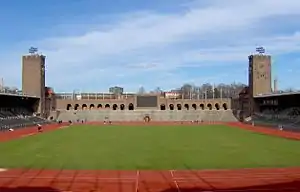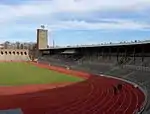Stockholm Olympic Stadium
Stockholm Olympic Stadium (Swedish: Stockholms Olympiastadion), most often called Stockholms stadion or (especially locally) simply Stadion, is a stadium in Stockholm, Sweden. Designed by architect Torben Grut, it was opened in 1912, its original use was as a venue for the 1912 Olympic Games. At the 1912 Games, it hosted the athletics, some of the equestrian, some of the football, gymnastics, the running part of the modern pentathlon, tug of war, and wrestling events.[1] It has a capacity of 13,145–14,500 depending on usage and a capacity of nearly 33,000 for concerts.
Stadion (The Stadium) | |
 | |

| |
| Full name | Stockholms Olympiastadion |
|---|---|
| Location | Stockholm, Sweden |
| Owner | Stockholm Municipality |
| Capacity | 14,417 Concerts: 33,000 |
| Field size | 105 x 68 m |
| Construction | |
| Built | 1910–1912 |
| Opened | 1 June 1912 |
| Architect | Torben Grut |
| Tenants | |
| Djurgårdens IF (1936–2013) AIK (1912–1936) Djurgårdens IF (women) (2015–) | |
Overview
The Stadium was the home ground for association football team Djurgårdens IF for many decades, until the more modern Tele2 Arena was inaugurated in 2013. Djurgårdens IF still has offices in the Stadium building.
In 1956, when Melbourne hosted the Olympics, the equestrian competitions were held here due to quarantine rules in Australia.[2] In 1958 the stadium was the venue of the European Athletics Championships. Finland-Sweden athletics international has been held here 29 times. The annual Stockholm Marathon finishes with a three quarter lap around the tracks of the stadium. Since 1967 the stadium has been the venue of the annual international athletics meeting DN Galan, from 2011 part of Diamond League. Originally, the north-east stand had two levels, increasing the capacity to about 20,000. After the Olympics, it was reduced to one level.
The Metro station Stadion was opened in 1973.
Some sections of the stadium were damaged by a bomb attack on 8 August 1997. Mats Hinze was later found guilty for it, who was against Stockholm's bid for the 2004 Summer Olympics.[3]
Other events
Since then, it has hosted numerous sports events, notably football and track and field athletics, but also for example, 50 Swedish Championship finals in bandy and hosted concerts.
In 1985, Bethany College head coach and future College Football Hall of Fame member Ted Kessinger brought the first American football team to play in Sweden. The Bethany "Terrible Swedes" defeated the Swedish all-star team 72–7.[4]
Records
It is one of the smallest athletics stadium ever used in a Summer Olympic Games.
Stockholms stadion has seen more athletics world records broken than any other stadium in the world, with a total of 83 as of 2008.[5]
The record attendance, for football, is 21,995 and was set on 16 August 1946, when Djurgårdens IF played AIK. The record attendance, for bandy, is 28,848 and was set 1959.
In 1995, The Rolling Stones performed at the stadium in front of 35,200 people.
Kiss sold out the stadium, by selling all 32,500 tickets in less than 20 minutes, during their 2008 World Tour. Kiss also played 2 nights at this stadium during their 1996–97 reunion tour Alive/Worldwide.
Michael Jackson performed on stage twice on July 17–18, 1992, during Dangerous World Tour. Each show had 53.000 viewers. Im total 106.000 viewers.
Bruce Springsteen has performed at the stadium no less than eight times. Twice in 1988, once 1993, twice in 1999 and again in 2009 playing three sold-out shows to approximately 100.000 people, being the only artist to have done so.
AC/DC performed at the stadium on 3 June 2010 in front of 32,768 people
Gallery
 Stockholms Olympiastadion as seen from the south at the opening of the 1912 Summer Olympics. For the Games, the capacity was 20.000.
Stockholms Olympiastadion as seen from the south at the opening of the 1912 Summer Olympics. For the Games, the capacity was 20.000.
 Western view of the stadium
Western view of the stadium Northern view of the stadium
Northern view of the stadium Eastern view of the stadium
Eastern view of the stadium
See also
References
- 1912 Summer Olympics official report. Archived 2008-04-10 at the Wayback Machine pp. 168–211.
- 1956 Summer Olympics official equestrian report. Archived 2018-12-25 at the Wayback Machine pp. 40–1. (in English and Swedish)
- "Archived copy". Archived from the original on 2015-10-27. Retrieved 2020-04-16.CS1 maint: archived copy as title (link)
- Nastrom, Stephaan (June 20, 1985). "Sweden's First Shot at Football a Success Despite 72–7 Defeat". The Victoria Advocate. p. 4b. Retrieved January 24, 2021.
- "DN Galan, friidrott" (in Swedish). www.stockholmtown.com. 2008-07-22. Retrieved 2008-08-08.
External links
![]() Media related to Stockholms Olympiastadion at Wikimedia Commons
Media related to Stockholms Olympiastadion at Wikimedia Commons
| Preceded by White City Stadium London |
Summer Olympics Main Venue (Stockholms Olympiastadion) 1912 |
Succeeded by Olympisch Stadion Antwerp |
| Preceded by White City Stadium London |
Olympic Athletics competitions Main Venue 1912 |
Succeeded by Olympisch Stadion Antwerp |
| Preceded by White City Stadium London |
Summer Olympics Football Men's Finals (Stockholms Olympiastadion) 1912 |
Succeeded by Olympisch Stadion Antwerp |


_pictogram.svg.png.webp)

